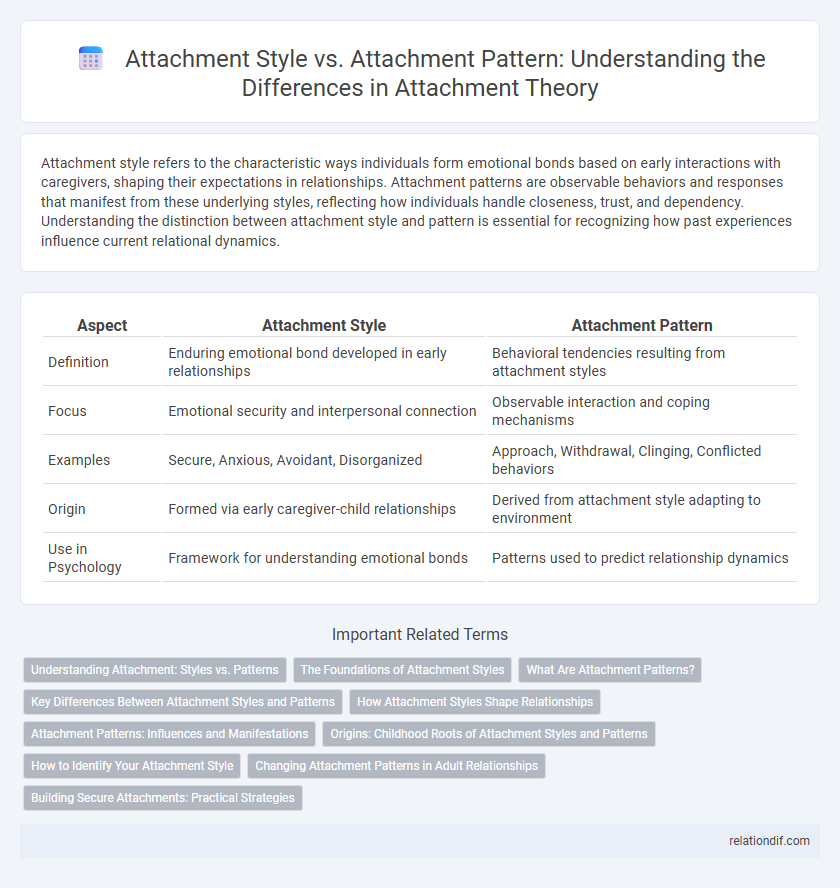Attachment style refers to the characteristic ways individuals form emotional bonds based on early interactions with caregivers, shaping their expectations in relationships. Attachment patterns are observable behaviors and responses that manifest from these underlying styles, reflecting how individuals handle closeness, trust, and dependency. Understanding the distinction between attachment style and pattern is essential for recognizing how past experiences influence current relational dynamics.
Table of Comparison
| Aspect | Attachment Style | Attachment Pattern |
|---|---|---|
| Definition | Enduring emotional bond developed in early relationships | Behavioral tendencies resulting from attachment styles |
| Focus | Emotional security and interpersonal connection | Observable interaction and coping mechanisms |
| Examples | Secure, Anxious, Avoidant, Disorganized | Approach, Withdrawal, Clinging, Conflicted behaviors |
| Origin | Formed via early caregiver-child relationships | Derived from attachment style adapting to environment |
| Use in Psychology | Framework for understanding emotional bonds | Patterns used to predict relationship dynamics |
Understanding Attachment: Styles vs. Patterns
Attachment style refers to the characteristic emotional bond individuals form with caregivers, typically categorized as secure, anxious, avoidant, or disorganized. Attachment pattern describes the behavioral and relational tendencies that emerge from these styles across different contexts and relationships. Understanding the distinction between attachment style and pattern is crucial for recognizing how early emotional bonds influence adult interpersonal dynamics and emotional regulation.
The Foundations of Attachment Styles
Attachment styles originate from early caregiver interactions, shaping emotional bonds and interpersonal behavior patterns throughout life. These foundational experiences form distinct attachment styles--secure, anxious, avoidant, or disorganized--that influence relational expectations and self-perception. Understanding the neurobiological and psychological underpinnings of these styles provides insight into emotional regulation and attachment-related behaviors.
What Are Attachment Patterns?
Attachment patterns refer to the consistent ways individuals behave and relate to others in close relationships, shaped by early experiences and emotional bonds. Unlike attachment styles, which categorize general tendencies as secure or insecure, attachment patterns provide a more detailed understanding of relational dynamics such as avoidance, anxiety, or ambivalence. Understanding these patterns helps identify how emotional needs and responses develop, influencing relationship satisfaction and stability.
Key Differences Between Attachment Styles and Patterns
Attachment style refers to the enduring emotional bonds formed in early relationships, typically categorized as secure, anxious, avoidant, or disorganized, influencing behavior across different contexts. Attachment patterns, however, describe the repetitive behavioral responses and interaction habits developed from these styles, reflecting how attachment styles manifest in specific relationships. Key differences lie in attachment style as the underlying emotional framework, while attachment patterns are the observable dynamics and coping mechanisms within relational experiences.
How Attachment Styles Shape Relationships
Attachment styles, rooted in early caregiving experiences, define consistent patterns of emotional bonding, influencing how individuals seek intimacy and respond to closeness in relationships. Secure attachment promotes trust and healthy communication, while anxious or avoidant styles often lead to challenges such as fear of abandonment or emotional distance. Understanding these attachment patterns enables better navigation of interpersonal dynamics, fostering stronger and more resilient connections.
Attachment Patterns: Influences and Manifestations
Attachment patterns reflect the dynamic ways individuals express and manage emotional bonds, shaped by early caregiving experiences and ongoing relational interactions. These patterns manifest in behaviors such as proximity seeking, trust development, and emotional regulation, influencing relationship stability and interpersonal communication. Understanding attachment patterns aids in identifying maladaptive cycles and fostering secure relational environments.
Origins: Childhood Roots of Attachment Styles and Patterns
Attachment styles and attachment patterns both originate from early childhood experiences with primary caregivers, shaping emotional bonds and relationship behaviors. Attachment styles refer to the enduring, organized ways individuals relate emotionally, often categorized as secure, anxious, avoidant, or disorganized, whereas attachment patterns describe specific, observable behaviors within relationships influenced by these foundational styles. The quality of caregiving, including responsiveness and consistency, critically impacts the formation of secure or insecure attachment, which subsequently influences social development and interpersonal dynamics throughout life.
How to Identify Your Attachment Style
Identifying your attachment style involves recognizing consistent patterns in how you form relationships, manage intimacy, and handle emotional closeness. Attachment styles--secure, anxious, avoidant, and disorganized--reflect underlying attachment patterns shaped by early caregiving experiences and influence adult relationship dynamics. Self-assessment tools and reflecting on personal relationship behaviors help reveal your attachment style, enabling targeted emotional growth and healthier connections.
Changing Attachment Patterns in Adult Relationships
Changing attachment patterns in adult relationships involves recognizing and modifying ingrained attachment styles, such as secure, anxious, avoidant, or disorganized, which influence emotional bonding and intimacy. Therapeutic interventions like cognitive-behavioral therapy and emotion-focused therapy help adults reframe maladaptive attachment patterns, promoting healthier relational dynamics. Consistent communication and self-awareness are key factors in transforming attachment patterns, fostering secure attachments over time.
Building Secure Attachments: Practical Strategies
Building secure attachments involves understanding the differences between attachment styles and attachment patterns, which influence how individuals connect emotionally. Implementing consistent responsiveness, fostering open communication, and promoting emotional safety are effective strategies to reshape insecure attachment patterns into secure attachment styles. Therapeutic approaches such as Emotionally Focused Therapy (EFT) and mindfulness practices significantly support the development of secure attachments by enhancing emotional regulation and trust within relationships.
attachment style vs attachment pattern Infographic

 relationdif.com
relationdif.com